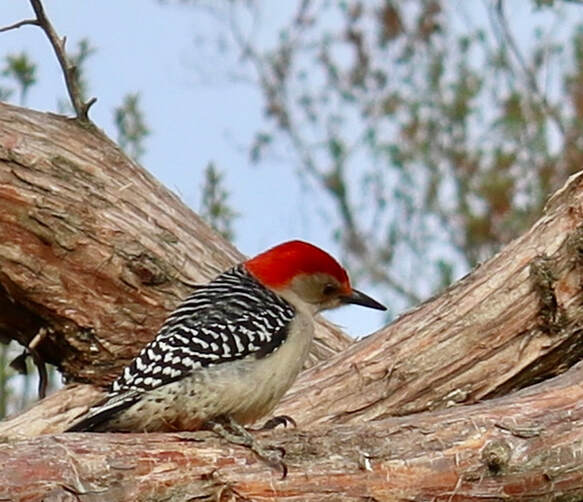 Red-bellied woodpecker; Credit: Charlene Uhl Red-bellied woodpecker; Credit: Charlene Uhl Sycamore Grove Farm, Madison County We have a healthy population of red-bellied woodpeckers (Melanerpes carolinus) on our farm. They regularly come to our bird feeder and can be seen flying over the farm throughout the day. One of their favorite places to land is on the electric poles that cross our property. I don’t think they are finding any insects in those poles but they have a good view of the open areas and surrounding trees. So why isn’t the Red-bellied woodpecker called a Red-headed woodpecker? After all, the last thing you notice on its belly is the slight rose blush. The story is that the red-headed woodpecker (Melanerpes erythrocecephalslus) was named first (and indeed its head and neck are bright red) so the name was already taken. The Red-bellied call is loud and frequently heard during the spring and summer. It could best be described as a loud trilling, descending in pitch. I love to research each bird I see on our farm: unique behaviors, their life span, what they eat, and aspects of their life. One of the things I found in researching the red-bellied is that it can stick out its tongue nearly 2 inches past the end of its beak. The tip is barbed and the bird’s spit is sticky (similar to a Pileated woodpecker), which allows them to snatch prey (primarily insects) from deep crevices in trees. I have seen them wedge nuts into crevices on top of one of our fence posts – then whack the nut into smaller pieces which they quickly consume. They are opportunistic feeders, eating berries, seeds, small invertebrates, as well as lizards, frogs, fish and bird nestlings. They even occasionally catch flying insects in the air. Like other woodpeckers, they may store nuts and seeds during the fall in crevices, to be eaten during the winter. The male red-bellied may excavate several holes, with the female selecting which one is completed and used. They may also use natural cavities, abandoned holes of other woodpeckers, or a nest box. In our area red-bellieds usually raise 2-3 broods each year. One of their major nest predators are European starlings (Sturnus vulgaris). Scientists have found that as many as half of all red-headed woodpecker nests in some areas get invaded by starlings. The life span of woodpeckers ranges from 4 - 11 years. The oldest known Red-bellied lived to over 12 years and was identified in the wild by his band. Birding tip: Birds are most active between dawn and 11 am. This is particularly the case in spring and early summer, when birds sing in the early morning. So get out there before your breakfast and you’re bound to see more birds than after lunch! Happy birding! Charlene Uhl
0 Comments
Your comment will be posted after it is approved.
Leave a Reply. |
Have a blog or blog idea?
Let us know (click) Other Blogs
VA Native Plant Society - click Brenda Clement Jones - click John Muir Laws' Blog - click Megan's Nature Nook - click Categories
All
Archives
September 2023
Blog Administrator:
Kathleen A. VMN since 2018 |